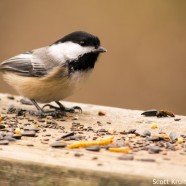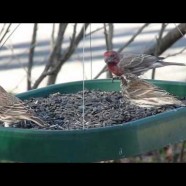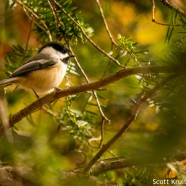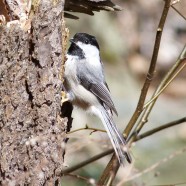Black-capped Chickadee Feeding
This Black-capped Chickadee (Poecile atricapillus) appeared to be a very indecisive feeder, not knowing what it wanted to eat and trying out some of the selections before tossing some back. I suppose that is the sort of thing you can do when you have piles of food strewn about you. Natural food sources are slowly being drawn down as we near the winter solstice. If you feed the birds you will likely be seeing more activity and action, even from the picky among them. Scott Kruitbosch Conservation & Outreach Coordinator
Read MorePurple Finch vs House Finch comparison with feeder birds
Here we have a female Purple Finch (Haemorhous purpureus) feeding throughout the video along with a female House Finch (Haemorhous mexicanus) and a male House Finch later on. A Tufted Titmouse (Baeolophus bicolor) and Black-capped Chickadee (Poecile atricapillus) also make an appearance among the common feeder birds visiting this tray of sunflower seeds. Note that the female Purple Finch is larger and bulkier than her House Finch counterpart. She has more boldly defined colors in all regards with additional heavier and stronger facial and head markings. Take a few watches to get a feel for...
Read MoreBlack-capped Chickadee (Poecile atricapillus) irruption
There have been Black-capped Chickadees (Poecile atricapillus) moving south in very subtle ways for a couple of months now. If you watch migratory hotspots you can sometimes detect their irruption years, especially if that location is not a particularly friendly habitat for the species. I have seen flocks of 10-20 birds tightly packed together and feeding on the move, possibly heading for a feeding station like yours. I always wonder what particular triggers end up notifying a widespread and highly adaptive bird like this one that they should nonetheless change their quarters for the autumn...
Read MoreBlack-capped Chickadee (Poecile atricapillus) by Scott Kruitbosch
This Black-capped Chickadee (Poecile atricapillus) is inspecting potential nest sites. Once it makes a home it will need peace, security and secrecy in order to successfully raise young. Please remember that we should not go anywhere near nests of birds like Piping Plovers, Bald Eagles, American Woodcock, and so forth. Our trail or scent can lead predators to them and our presence is interpreted as an attack in itself! This harms and kills eggs and young birds every year. Please respectfully admire nesting birds from a safe distance.
Read More







